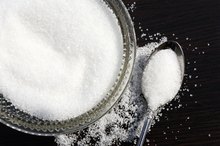Foods a Borderline Diabetic Should Avoid
With borderline diabetes, or prediabetes, blood sugar levels are higher than normal but not as high as with type 2 diabetes (T2DM). Underlying prediabetes is a condition called insulin resistance. With this condition, the body stops responding normally to insulin, the hormone that enables cells to absorb and use blood sugar, or glucose.
Prediabetes occurs when muscle, fat and liver cells have become so resistant to insulin that glucose builds up in the blood.
The good news for people with prediabetes is that changes in diet, along with exercise and weight loss, can delay or prevent progression to T2DM. Knowing what foods to avoid helps you create a healthy diet for borderline diabetes.
Sugary Foods
Carbohydrates include sugars, starch and fiber. While fiber passes through the digestive system largely unchanged, sugars are quickly digested and absorbed into the bloodstream. This leads to a rise in blood sugar level, which varies depending on the food source.
Fruits, vegetables, dairy products and whole-grain foods are healthful sources of carbohydrates for people with prediabetes because they provide needed fuel for the body along with various other beneficial nutrients. But sugary foods like desserts, candy and sugar-sweetened beverages are high in calories and aren't very nutritious.
A wide-ranging July 2015 "BMJ" review of 17 studies representing 189.1 million U.S. adults found that regularly drinking sugar-sweetened beverages increases the risk for T2DM by 13 percent for each daily serving. The original risk estimates were higher but were revised to exclude obesity as a contributing factor, as it may have distorted the findings.
While you don't have to eliminate these foods, the ADA suggests reserving them for special occasions and eating a small portion. This helps with weight control, which is important for reducing your risk of developing T2DM.
- Carbohydrates include sugars, starch and fiber.
- Fruits, vegetables, dairy products and whole-grain foods are healthful sources of carbohydrates for people with prediabetes because they provide needed fuel for the body along with various other beneficial nutrients.
Refined-Grain Foods
Is the Atkins Diet Good for Type 2 Diabetes?
Learn More
Grain foods contain variable amounts of starch and fiber.
Starch is digested into glucose, which affects blood sugar levels. Fiber is the indigestible part of plant foods, including fruits, vegetables, beans and grains.
Because it's not digested, fiber doesn't increase blood sugar. In fact, high-fiber foods can help control blood sugar levels by slowing and reducing absorption of sugar from the digestive system.
Refined grains are milled, a process that removes most of the fiber along with some beneficial vitamins and minerals. Examples include white rice and white flour. Foods made with refined grains generally cause greater blood sugar spikes than whole-grain foods, as reported in a December 2008 "American Journal of Clinical Nutrition" article 3.
This is important because large blood sugar fluctuations cause surges in chemicals called free radicals, note the authors of an April 2006 "JAMA" study report. High levels of free radicals may contribute to the progression of prediabetes to T2DM.
The ADA recommends choosing whole-grain, high-fiber foods instead of refined-grain foods.
**Examples of foods to avoid or limit include: -- White-flour breads, pastas and crackers.
** -- Refined-grain cereals such as corn flakes, puffed rice and instant oatmeal. -- White rice and couscous.
- Grain foods contain variable amounts of starch and fiber.
- Foods made with refined grains generally cause greater blood sugar spikes than whole-grain foods, as reported in a December 2008 "American Journal of Clinical Nutrition" article 3.
Foods High in Unhealthy Fats
Consumption of fat does not directly affect blood sugar.
But a high-fat, high-calorie diet increases the risk for prediabetes and T2DM. Additionally, prediabetes increases the risk for heart disease. For these reasons, it's important for people with borderline diabetes to limit foods high in saturated fats and to avoid any trans fats. The ADA recommends that people with prediabetes follow the same guidelines as the general population for fat consumption 5. The American Heart Association recommends limiting saturated fat to 5 to 6 percent of daily calories 257. On a 2,000-calorie diet, this equates to no more than 13 g per day. Saturated fats come from animal foods, including meat, eggs and dairy products.
Examples of foods high in saturated fats to limit or avoid if you have prediabetes include: -- Fatty cuts of beef, pork, lamb and other red meats.
-- Processed meats, such as sausage, bacon and deli meats. -- Poultry with the skin. -- Butter, and full-fat milk and cheese.
Trans fats are more harmful than saturated fats in terms of increased heart disease risk. Small amounts of trans fats occur naturally in a few animal foods. Artificial trans fats, also known as partially hydrogenated oils, are created to solidify vegetable oils. Trans fats have historically been used in many processed and fast foods. Due to health risks, however, the U.S. Food and Drug Administration is requiring elimination of trans fats from all manufactured foods by 2018. While many manufacturers have already eliminated trans fats from their products, check the nutrition label and ingredients to be sure foods are free of trans fats.
According to the Cleveland Clinic, foods to avoid that may still contain trans fats include: -- Ready-to-eat cakes, pastries, biscuits and breakfast sandwiches. -- Chips, microwave popcorn and other snack foods.
**-- Frozen food with a crust, such as pizza and pot pies.
** -- Baking mixes and ready-to-eat frosting. -- Margarine.
- Consumption of fat does not directly affect blood sugar.
- Examples of foods high in saturated fats to limit or avoid if you have prediabetes include: -- Fatty cuts of beef, pork, lamb and other red meats.
- -- While many manufacturers have already eliminated trans fats from their products, check the nutrition label and ingredients to be sure foods are free of trans fats.
Can Splenda or Equal Raise Your Blood Sugar?
Learn More
The National Institutes of Health (NIH) reports that prediabetes usually progresses to T2DM within 10 years unless lifestyle changes are made. However, with proper nutrition, exercise and modest weight loss, people with prediabetes can significantly delay or prevent the development of T2DM. A large NIH-sponsored study involving 3,234 overweight people with prediabetes showed that losing a mere 7 percent of body weight along with 150 minutes of exercise weekly reduced the rate of progression to T2DM by 34 percent over 10 years, compared to no treatment. In addition, treatment with an oral diabetes medication called metformin (Glucophage, Glumetza, Fortamet) reduced the rate of T2DM development by 18 percent.
The ADA recommends an individualized diet for people with prediabetes. So it's important to talk with your doctor and dietitian about the best nutrition plan for you and what foods to avoid or limit.
- The National Institutes of Health (NIH) reports that prediabetes usually progresses to T2DM within 10 years unless lifestyle changes are made.
- In addition, treatment with an oral diabetes medication called metformin (Glucophage, Glumetza, Fortamet) reduced the rate of T2DM development by 18 percent.
Related Articles
References
- BMJ: Consumption of Sugar Sweetened Beverages, Artificially Sweetened Beverages, and Fruit Juice and Incidence of Type 2 Diabetes: Systematic Review, Meta-Analysis, and Estimation of Population Attributable Fraction
- American Diabetes Association: Types of Carbohydrates
- American Journal of Clinical Nutrition: Glycemic Index, Postprandial Glycemia, and the Shape of the Curve in Healthy Subjects: Analysis of a Database of More Than 1000 Foods
- JAMA: Activation of Oxidative Stress by Acute Glucose Fluctuations Compared With Sustained Chronic Hyperglycemia in Patients With Type 2 Diabetes
- American Diabetes Association Practice Guidelines: Nutrition Therapy Recommendations for the Management of Adults With Diabetes
- Circulation: Red and Processed Meat Consumption and Risk of Incident Coronary Heart Disease, Stroke, and Diabetes Mellitus A Systematic Review and Meta-Analysis
- American Heart Association: Trans Fats
- Sheng Z, Cao JY, Pang YC, et al. Effects of lifestyle modification and anti-diabetic medicine on prediabetes progress: A systematic review and meta-analysis. Front Endocrinol (Lausanne). 2019 Jul 12;10:455. doi:10.3389/fendo.2019.00455
- Centers for Disease Control and Prevention. Prediabetes—your chance to prevent type 2 diabetes. Last reviewed June 11, 2020.
- National Institute of Diabetes and Digestive and Kidney Diseases, Risk factors for diabetes: Prediabetes xcreening, how and why
- Moin T. Should adults with prediabetes be prescribed metformin to prevent diabetes mellitus? Yes: High-quality evidence supports metformin use in persons at high risk. Am Fam Physician. 2019 Aug 1;100(3):134-135.
Resources
- American Dietetic Association Complete Food and Nutrition Guide, 4th Edition; Roberta Larson Duyff
- Journal of the American College of Cardiology: Pre-Diabetes and the Risk for Cardiovascular Disease: A Systematic Review of the Evidence
- Circulation: 2013 AHA/ACC Guideline on Lifestyle Management to Reduce Cardiovascular Risk
Writer Bio
Alexandra Kaplan Corwin is a registered dietitian and certified diabetes educator. She works at Montefiore Medical Center in Pediatric Endocrinology and Diabetes and has a private practice in Ardsley, N.Y., where she counsels adults and children for various medical conditions and weight loss. She completed her Master of Science in clinical nutrition at New York University and holds an undergraduate degree from Cornell University.









